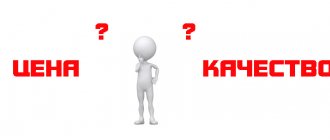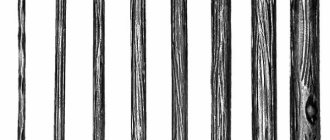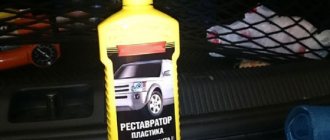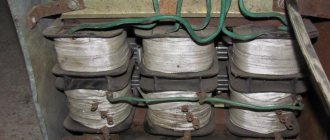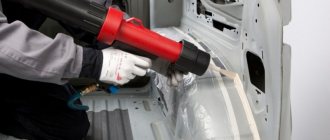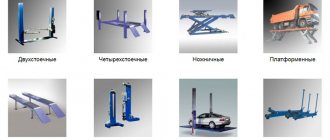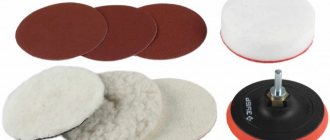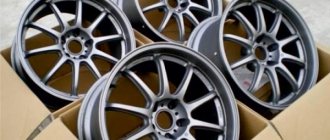Welding is very often used in car body repairs. However, simply connecting metal parts is not everything. Everything needs to be beautiful, neat and unnoticeable. In the video and article you will learn how to properly process welding seams.
The procedure for processing a weld seam will be considered using the example of a stand:
It is already neatly cut, without gaps and tacked:
Why can't you weld with a continuous seam?
Let's start with the fact that not all places cannot be welded with a continuous seam. Although, it is better not to use it everywhere. Pay attention, for example, to airplanes - there are no welds anywhere, there are rivets everywhere. A continuous seam will simply burst when twisting the metal.
In addition, when welding with a continuous seam, the part becomes very hot. In this case, not only the place that is heated is heated, but also all adjacent ones. The longer you cook, the wider the heating zone. Because of this, the metal can lead.
You need to cook in spots. At first, the distance between them should be approximately 5 cm. Then between them you need to weld another point. After that, one more point at a time between these new ones - until the seam becomes continuous, if you need it so much.
Attention! You need to cook in spots, be sure to let the metal cool. It is impossible to cool the metal artificially - otherwise it will shrink.
Welding and seam processing
1. Weld the material with short seams 1 cm long. There should be a distance of 1 cm between the seams. If the material “shoots”, it means you haven’t cleaned it well. If the welding surface is large, you can alternately weld sections from different sides.
2. Clean the seam with a grinder. After sanding, the seam should look something like this:
3. Apply epoxy primer It is not necessary to do it in a thick layer. The primer is applied to prevent the seam from oxidizing. If there is rust on the seam, it must be treated with acid primer. Epoxy primer has a very dense structure and protects the metal from moisture and air.
Let it dry for a day. Next, you can fill it with a 120- or 240-grit sandpaper to give the soil roughness.
Attention! The soil cannot be heated with a hairdryer; with its help you will dry only the top layer - nothing will dry under it.
4. Putty the weld seam
Welding the bottom
It is not recommended to weld the bottom with rolled ferrous metal, which is sold everywhere - it is highly susceptible to rust. Over time, such metal will transfer rust to the material to which it was welded, even if cleaned until clean.
A great solution is to use an old hood. Cut a section out of it and cook! It bends well, so it is very versatile. You weld the corners and tap in the middle, whatever you like - it can be given any shape. In addition, rust will not be transferred after welding. It is recommended to use metal from old foreign cars: hoods, fenders, roofs, etc.
Corrosion is when the surface of solids begins to deteriorate under the influence of chemical or electrochemical reactions or under the influence of the environment. It can appear on wood, plastic and concrete, and the metal from which cars are made begins to undergo this process already at the production stage of the vehicle.
This process continues during transportation and storage, but comes into full force during vehicle operation. Corrosion can completely destroy a car and turn iron into its oxide, which is popularly called rust. Many car owners mistakenly believe that once rust appears on the body surface, it is no longer possible to get rid of it and you just need to accept it and come to terms with it. This is often due to simple ignorance of modern technologies, including ways to combat this phenomenon. In particular, anti-corrosion treatment of the car yourself or at a service center will help prevent property damage. This method does not guarantee complete elimination of this phenomenon, but it significantly slows it down and helps maintain the vehicle in working order.
Methods for processing welds
Cleaning welded areas is a difficult process, requiring skills and sometimes complex equipment. The first thing you need to do whenever processing welded areas is to choose a method. There are only three main ones:
- Mechanical . It assumes that areas will be cleared with manual tools. Effectively removes scale.
- Thermal . Here you need heating and cooling according to a scheme selected according to the material of the part. It heats up either completely or only in the stripping area.
- Chemical . A compound is applied to the area that strengthens it and protects it from corrosion. Typically this method is used on those parts that are used in active environments.
It is impossible to say which method of cleaning welds after welding is the best, since each will be useful in some way.
There are often situations when all three methods are used sequentially on the same seam.
Causes of corrosion on a car
All vehicles without exception are subject to this, regardless of which manufacturer they were produced by. To a lesser extent, it affects cars produced in a single copy on a personal order. As a rule, they are subjected to anti-corrosion treatment at the first stages of production. But even such measures are not able to completely rid the vehicle of this harmful phenomenon. With further operation of the car, especially in large cities and metropolitan areas, the process of destruction of metal by rust receives favorable conditions for its development. The acceleration of corrosion is facilitated by small scratches and chips that a car can receive when driving on a poor quality road.
We begin the car processing process
Properly performed anti-corrosion treatment of a car with your own hands will not harm the car, because the layer of application of any component for protection must be of a minimum thickness. And its application to the body or assembly should be done extremely carefully. Before you begin measures to protect your car from corrosion phenomena, you should carry out preparatory measures:
- Free up space in the trunk and remove the sound insulation layer from it.
- Then remove the mats and insulation under the hood, that is, all coverings that can prevent you from reaching the body surface.
- Carefully remove any swollen paint and clean off any rusty areas.
- Rinse the car thoroughly, paying special attention to hard-to-reach areas. Professionals recommend washing your car before the upcoming anti-corrosion treatment in three stages with water at a temperature of at least 70 degrees. First, it will be enough to pour plenty of water on the car. After this, all areas should be thoroughly washed with detergents. And at the end, rinse the entire car thoroughly.
- Wipe the body dry to remove any remaining water with a soft cloth.
- The thresholds should be washed and dried especially carefully.
- Some rust preventatives can corrode rubber components, so remove any rubber that may be in contact.
- Cover the seats in the cabin with cellophane or thick rags so as not to accidentally stain them during the work.
- The pedals and the floor underneath them should also be carefully covered. The resulting coating is quite slippery and no one wants their soles to slide on the pedals.
Now you can begin preparing tools and materials for work. Regardless of the complexity of the repair, you will need:
- the anti-corrosion agent itself;
- drill or screwdriver;
- spray;
- paint brush;
- metal drill;
- simple plumbing tools
- rags;
- plugs for holes of different sizes.
In most cases, car owners carry out selective anti-rust treatment of those body elements that are most vulnerable to harmful influences - the underbody of the car and wheel arches. In addition, it is advisable to protect with an anti-corrosion mixture the places where moisture accumulates the most, such as the car pillars, its sills, welding points and joints on body bends.
Complete processing consists of several stages. The bottom and wheel arches are subject to a two-layer application of the mixture. It is mandatory to treat hidden areas of the car, its welds and joints on bends. The surfaces inside the hood and trunk are treated in one layer.
Mechanical cleaning
An important stage of welding is not only the implementation of preparatory work, but also the correct cleaning of the welds. This process is mandatory and is enshrined in the relevant GOST.
Symbols for welds.
So how do you clean a welded joint? The easiest way to clean a weld is to simply brush with a wire brush. However, using a portable sander or a simple grinder with a sanding wheel for stripping will be more effective.
This simple processing method will allow you to get rid of the most common defects, which include scale, oxides, traces of tarnish, and burrs. As a result, the joint of the workpiece will be of higher quality.
In terms of price-quality ratio, this technology is one of the most profitable methods for preparing edges before and after welding. In this regard, it is not surprising that most masters use this method.
When choosing a grinding wheel to clean a seam after welding, it is important to take into account some nuances, otherwise you should not expect a good processing result. Preference should be given to attachments with fabric-based petals.
It is characterized by higher wear resistance compared to paper versions, which is necessary in such an aggressive type of work as grinding welding joints.
The best material for processing stainless steel after welding is aluminum zirconate. It is characterized by fairly high strength and does not have a corrosive effect on the metal.
It should be borne in mind that fabric-based attachments with this coating are expensive. However, in this case it is better not to save money, because with the right tool the job will be easier and the end result will be of better quality.
https://youtu.be/mZnkrJ7_W_U
Do-it-yourself anti-corrosion treatment of a car is considered complete
Of course, the work done will not give you a guarantee that doing this procedure just once will be enough. The coating will deteriorate over time and there will be a need to apply a new one. But carefully applied mastic will protect your car from corrosion for a long time. The service life of the anti-corrosion mixture will depend on many conditions, including the quality of the mixture used, compliance with the technological processes for its application, the initial condition of the car and its operating conditions.
The urgency of carrying out work to protect your car is explained by the speed of the process of destruction of metal by rust, which is facilitated by the increased humidity of air masses in certain regions and the use of chemical reagents on urban roads. Nowadays, even when buying a car at a prestigious dealership, experts recommend treating the body with an anti-corrosive agent. This is due to the fact that not all manufacturers pay due attention to this important issue. And car owners have to do the treatment themselves or at a car service center. However, not everyone can afford to entrust this work to service technicians, because this is a rather expensive procedure, and, again, no one can vouch for the quality.
What is the need for processing?
Welding affects the metal structures being held together more than it seems. At this moment, the parts develop a lot of internal stress. And because of it, they can become deformed and become more fragile, which leads to rapid destruction.
Welding also affects the chemical, physical and mechanical properties of metals, since uneven heating of parts during the bonding process leads to disruption of the crystal lattice of the material.
To restore lost properties to parts, processing is done at the bonding points. Stripping helps not only strengthen the structure, increase its ductility, but also protect welds from corrosion and rust.
Types of body sealants and application
Let's look at the main types that are used in car body repair.
1. Seam sealant in a tube (cartridge) 300 ml. This type is probably the most common and frequently used. This is a one-component composition mainly intended for sealing seam joints. This type is the best sealant for creating a perfect seam. To use it, you need a special sealant gun.
Such pistols are available both mechanical and pneumatic.
Car sealant in tubes is used for sealing rolled seams, internal parts of doors, hood, trunk, and in the engine compartment. They come in different colors, white, black, beige, gray, to create the optimal substrate.
2. Seam sealant under the brush. This type is produced in 1 kilogram jars; it is also a one-component composition, which is intended for application with a brush. It is excellent for gluing metal parts, for filling butt and weld seams
Automotive brush seam sealant is often used for connecting parts of the luggage compartment, engine compartment, under bumper area and other invisible elements. It provides reliable protection against moisture and corrosion. Also has different colors, white, black, beige, gray.
3. Automotive sealant tape. Seam tape for creating a perfectly even seam. It has an adhesive base, is lightweight and very easy to use. Does not require drying and can be painted immediately.
4. It is also worth paying attention to the car sealant in a tube (150 ml). It is suitable for some small jobs. Has the same characteristics and functions as above. Available in various colors: white, black, gray, beige.
For example, consider several popular brands and types.
Chemical purification of the compound
As already described above, mechanical processing allows you to achieve acceptable results, however, the best quality of cleaning the weld after welding is achieved when this method is combined with chemical cleaning. This includes etching and passivation.
Chemical for cleaning seams.
Etching is carried out using specialized compounds. They allow you to obtain a uniform anti-corrosion coating on the surface of the product. In addition, areas with tarnish are removed - places where chromium and nickel oxides accumulate, which are characterized by low corrosion resistance.
Small areas of the seams to be treated are etched by simply applying the compound to the required area. In some cases, the product is completely dipped into a container with a special solution. The interaction time of the part with the mixture is different in each specific case and is selected individually.
Passivation is the process of treating a metal product with a special solution. As a result of this process, a protective film is formed on the treated surface of the part. A distinctive feature of the resulting coating is its resistance to corrosion.
The essence of this technology for cleaning edges for welding is the use of mild oxidants. As a result of interaction with stainless steel, free metal is removed from its surface and the formation of a protective coating on the surface of the product is activated.
Passivation can be carried out using sprays for treating stainless steel or a special paste.
After completing the passivation procedure, all reagents from the surface of the part should be removed by rinsing under water. Disposal of wastewater after such washing must be carried out in accordance with state standards of natural legislation.
The fact is that such water contains an increased amount of acids and heavy metals, so such wastewater is characterized by an increased danger to the environment. First, acids should be neutralized using alkaline solutions, and then the water should be filtered. The resulting waste must be disposed of.
Body 999 sealant
Body 999 sealant is very popular and can be found in almost every painting store.
Bodysuit 999 is available in almost all of the above options. This is a 150 ml tube, 300 ml cartridge. and a 1 liter jar. Consists of a rubber base and various resins. Used to seal metal and protect it from environmental influences. Retains its elasticity for a long time. Virtually no shrinkage. Even with a very thick layer it does not crack and has excellent adhesion to the surface.
Surfaces to be applied:
- Steel
- Old paintwork
The product is ready for application and does not require additional dilution. After drying, it can be painted with any type of enamel. Apply exclusively to the internal parts of the car.
3M sealant for car
3M sealants have long proven themselves in body repair. They have a large range of materials for various needs. Consider 3M 08684. This is a one-component polyurethane composition in gray (also available in black and white). Designed for processing seams around doors, joining panels, car floors, etc.
This 3M polyurethane body sealant has the following characteristics:
- Good to apply
- Doesn't spread
- Dries quickly
- After drying it has high hardness and elasticity
- Dries in harsh conditions (humidity, low temperature)
There are also 3M automotive body sealants for weld seams (welding seams), but as practice shows, it is still recommended to first treat them with acidic primer or epoxy.

